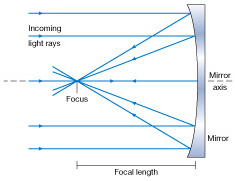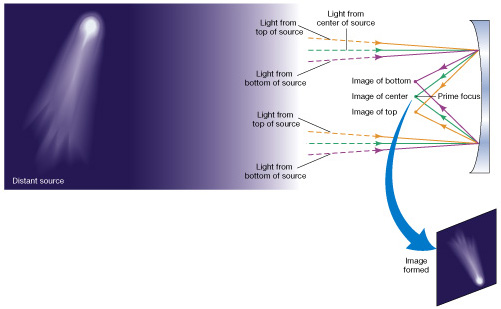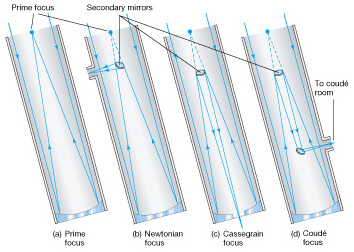Pre-lab #5 Telescopes
Simply put, a telescope is a “light bucket”—a device whose primary function is to capture as much radiation as possible from a given region of the sky and concentrate it into a focused beam for analysis. We begin our study of astronomical hardware with optical telescopes, designed to collect wavelengths visible to the human eye. Later we will turn our attention to telescopes designed to capture and analyze radiation in other, invisible regions of the electromagnetic spectrum. As we will see throughout this text, advances in our understanding of the universe have always gone hand in hand with technological improvements in both the sensitivity and the spectral range of our detectors. This coupling between technology and science is as vital today as it was when Galileo first turned his telescope toward the skies. (Sec. 1.3)
Reflecting and Refracting Telescopes
Optical telescopes fall into two basic categories—reflectors and refractors. Figure 3.1 shows how a reflecting telescope uses a curved mirror to gather and concentrate a beam of light. This mirror, usually called the primary mirror because telescopes generally contain more than one, is constructed so that all light rays arriving parallel to its axis (the imaginary line through the center of and perpendicular to the mirror), regardless of their distance from that axis, are reflected to pass through a single point, called the focus. The distance between the primary mirror and the focus is the focal length. In astronomical contexts, the focus of the primary mirror is referred to as the prime focus.
|
|
|
Figure 3.2 Refracting Lens (a) Refraction by a prism changes the direction of a light ray by an amount that depends on the angle between the prism’s faces. (b) A lens can be thought of as a series of prisms. A light ray traveling along the axis of a lens is unrefracted as it passes through the lens. Parallel rays arriving at progressively greater distances from the axis are refracted by increasing amounts, in such a way that all are focused to a single point. |
A refracting telescope uses a lens instead of a mirror to focus the incoming light, relying on refraction rather than reflection to achieve its purpose. Refraction is the bending of a beam of light as it passes from one transparent medium (for example, air) into another (such as glass). Figure 3.2(a) illustrates the process and shows how a prism can be used to change the direction of a beam of light. As illustrated in Figure 3.2(b), we can think of a lens as a series of prisms combined in such a way that all light rays striking the lens parallel to the axis are refracted to pass through the focus.
Optical telescopes are often used to make images of their fields of view. Figure 3.3 illustrates how this is accomplished, in this case by the primary mirror in a reflecting telescope. Light from a distant object reaches the telescope as nearly parallel rays. A ray of light entering the instrument parallel to the mirror axis is reflected through the focus. Light from a slightly different direction—that is, at a slight angle to the axis—is focused to a slightly different point. In this way, an image is formed near the focus. Each point in the image corresponds to a different angle in the field of view. Often, the image is magnified with a lens known as an eyepiece before being viewed by eye or recorded using a camera. Figure 3.4(a) shows the basic design of a simple reflecting telescope, illustrating how a small secondary mirror and an eyepiece are used to view the image. Figure 3.4(b) shows how a refracting telescope accomplishes the same function.
The two telescope designs shown in Figure 3.4 achieve the same result—light from a distant object is captured and focused to form an image. However, as telescope size has steadily increased over the years (for reasons to be discussed in Section 3.2), a number of important factors have tended to favor reflecting instruments over refractors:
- Just as a prism separates white light into its component colors, the lens in a refracting telescope focuses red and blue light differently. This deficiency is known as chromatic aberration. Careful design and choice of materials can largely correct this problem, but it is difficult to eliminate it entirely, and it requires the use of very high-quality glass for the body of the lens. Mirrors do not suffer from this defect.
- As light passes through the lens, some of it is absorbed by the glass. This absorption is a relatively minor problem for visible radiation, but it can be severe for infrared and ultraviolet observations because glass blocks most of the radiation coming from those regions of the electromagnetic spectrum. This problem obviously does not affect mirrors.
- A large lens can be quite heavy. Because it can be supported only around its edge (so as not to block the incoming radiation), the lens tends to deform under its own weight. A mirror does not have this drawback because it can be supported over its entire back surface.
- A lens has two surfaces that must be accurately machined and polished, which can be a difficult task. A mirror has only one surface.
For these reasons, all large modern optical telescopes are reflectors.
|
|
|
Figure 3.4 Reflectors and Refractors Comparison of (a) reflecting and (b) refracting telescopes. Both types are used to gather and focus electromagnetic radiation to be observed by human eyes or recorded on photographs or in computers. In both cases, the image formed at the focus is viewed with a small magnifying lens called an eyepiece. |
Telescope Design
Figure 3.5 shows some basic reflecting telescope designs. Radiation from a star enters the instrument, passes down the main tube, strikes the primary mirror, and is reflected back toward the prime focus, near the top of the tube. Sometimes astronomers place their recording instruments at the prime focus. However, it can be very inconvenient, or even impossible, to suspend bulky pieces of equipment there. More often, the light is intercepted on its path to the focus by a secondary mirror and redirected to a more convenient location, as in Figures 3.5(b) through (d).
In a Newtonian telescope (named after Isaac Newton, who invented this design), the light is intercepted by a flat secondary mirror before it reaches the prime focus and deflected 90°, usually to an eyepiece at the side of the instrument (Figure 3.5b). This is a popular design for smaller reflecting telescopes, such as those used by amateur astronomers.
Alternatively, astronomers may choose to work on a rear platform where they can use detecting equipment too heavy or delicate to hoist to the prime focus. In this case, the light reflected by the primary mirror toward the prime focus is intercepted by a convex secondary mirror, which reflects the light back down the tube and through a small hole at the center of the primary mirror (Figure 3.5c). This arrangement is known as a Cassegrain telescope (after Guillaume Cassegrain, a French lensmaker). The point behind the primary mirror where the light from the star finally converges is called the Cassegrain focus.
In a variant on the Cassegrain design, light is first reflected by the primary mirror toward the prime focus and reflected back down the tube by a secondary mirror. A third, much smaller mirror then reflects the light into an environmentally controlled laboratory (Figure 3.5d). Known as the coudé room (from the French word for “bent”), this laboratory is separate from the telescope, enabling astronomers to use very heavy and finely tuned equipment that could not possibly be lifted to either the prime focus or the Cassegrain focus.
|
|
|
Figure 3.5 Reflecting Telescopes Four reflecting telescope designs: (a) prime focus, (b) Newtonian focus, (c) Cassegrain focus, and (d) coudé focus. Each design uses a primary mirror at the bottom of the telescope to capture radiation, which is then directed along different paths for analysis. |







